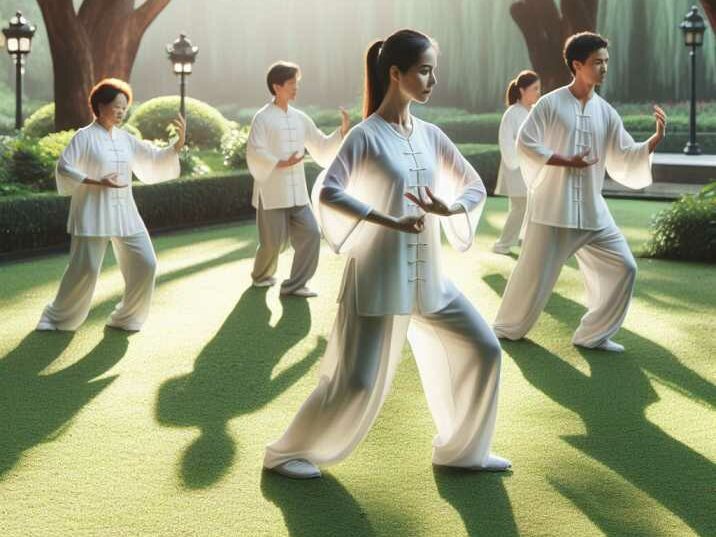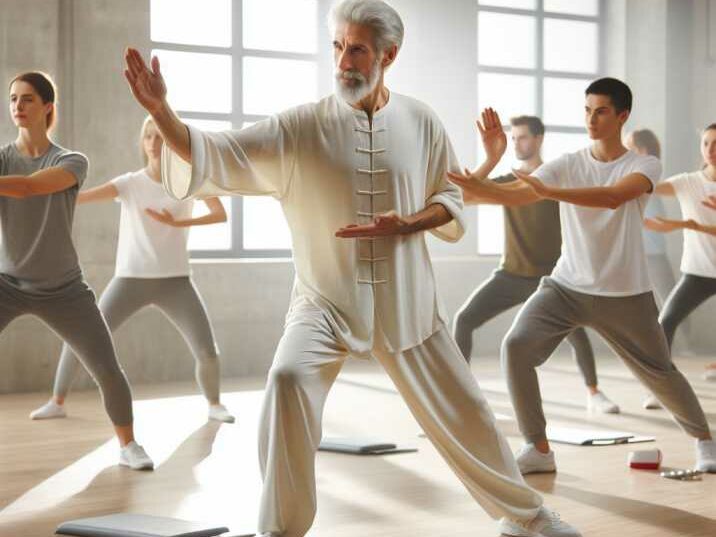Introduction:
Table of Contents
Tai Chi, with its mesmerizing blend of graceful movements and meditative tranquility, has captivated the hearts and minds of enthusiasts worldwide. Yet, amidst its serene beauty lies a persistent question: Does Tai Chi involve fighting? Join us as we delve deep into the essence of Tai Chi, exploring its rich history, core principles, and its relevance in today’s world.

Does tai chi involve fighting?
1. The Ancient Origins of Tai Chi
Tracing Its Roots in Ancient China: Tai Chi’s origins can be traced back to the rich tapestry of ancient Chinese martial arts. Developed as a system of self-defense, it embodies the wisdom of centuries-old traditions.
Legends and Lore: The Story of Zhang Sanfeng: According to legend, Tai Chi was founded by Zhang Sanfeng, a Taoist monk who witnessed a battle between a snake and a crane. Inspired by their fluid movements, he created Tai Chi as a way to harmonize opposing forces.
2. Unveiling the Core Principles of Tai Chi
Harmony of Yin and Yang: At its core, Tai Chi embodies the principle of balance between Yin and Yang – opposing yet complementary forces. Through Tai Chi practice, practitioners seek to harmonize these energies within themselves.
Integration of Mind, Body, and Spirit: Tai Chi is not merely a physical exercise but a holistic practice that integrates mind, body, and spirit. Its slow, deliberate movements serve as a meditation in motion, fostering inner peace and awareness.
3. Tai Chi as a Martial Art: Debunking Myths
Dispelling the Combat Myth: Contrary to popular belief, Tai Chi is not primarily focused on combat or aggression. While it does contain martial applications, its emphasis lies more on self-cultivation and personal development.
Exploring Tai Chi’s Practical Applications: Tai Chi’s martial roots are evident in its defensive techniques and strategic postures. However, its effectiveness in combat situations may vary, with emphasis placed on cultivating internal strength and agility.
4. The Poetry of Motion: Understanding Tai Chi Forms
Slow and Deliberate Movements: Tai Chi forms are characterized by their slow, deliberate movements, performed with grace and precision. Each movement flows seamlessly into the next, creating a continuous cycle of energy.
Cultivating Mindfulness and Presence: Through the practice of Tai Chi forms, practitioners cultivate mindfulness and presence, heightening their awareness of the present moment. This meditative quality is integral to the transformative power of Tai Chi.
5. The Health Benefits of Tai Chi
Enhancing Physical Well-being: Numerous studies have demonstrated the physical benefits of Tai Chi, including improved balance, flexibility, and cardiovascular health. Its gentle, low-impact nature makes it suitable for people of all ages and fitness levels.
Promoting Mental Clarity and Emotional Balance: In addition to its physical benefits, Tai Chi promotes mental clarity and emotional balance. Regular practice has been shown to reduce stress, anxiety, and depression, while enhancing overall well-being.
6. Tai Chi in the Modern World: Adapting to Contemporary Needs
Tailoring Tai Chi for Different Audiences: In recent years, Tai Chi has undergone adaptations to meet the needs of diverse populations, including seniors, individuals with disabilities, and those seeking stress relief or rehabilitation.
Incorporating Tai Chi into Healthcare and Wellness Programs: Tai Chi’s therapeutic benefits have led to its integration into healthcare and wellness programs worldwide. From hospitals to community centers, Tai Chi is recognized as a valuable tool for promoting health and well-being.
7. Exploring the Science Behind Tai Chi
Scientific Studies and Research Findings: A growing body of scientific research supports the efficacy of Tai Chi in promoting health and well-being. Studies have shown improvements in balance, mobility, pain management, and overall quality of life among Tai Chi practitioners.
Understanding the Physiological and Psychological Effects: Tai Chi’s physiological effects include improved circulation, muscle strength, and flexibility, as well as reduced inflammation and pain. Psychologically, it promotes relaxation, stress reduction, and emotional resilience.

Table of Information about Does Tai Chi involve fighting?
| Aspect | Description |
|---|---|
| Origins | Originated in ancient China as a martial art and system of self-defense |
| Founder | Legend attributes its creation to Taoist monk Zhang Sanfeng |
| Core Principles | Harmony of Yin and Yang, Integration of Mind, Body, and Spirit |
| Forms | Slow, deliberate movements performed with precision and mindfulness |
| Martial Applications | Defensive techniques and strategic postures rooted in combat principles |
| Health Benefits | Improved balance, flexibility, cardiovascular health, stress reduction |
| Modern Adaptations | Tailored programs for seniors, individuals with disabilities, wellness |
| Scientific Endorsement | Recognized by organizations like NIH and WHO for health benefits |
| Common Misconceptions | Viewed solely as a martial art, Limited to elderly populations |
Conclusion:
In conclusion, Does Tai Chi involve fighting? Tai Chi transcends its martial origins to become a timeless art form that nurtures both body and soul. Its slow, deliberate movements offer a pathway to physical vitality, mental clarity, and emotional balance. Whether practiced for health, meditation, or self-defense, Tai Chi remains a source of inspiration and transformation for countless individuals around the world.
Frequently Asked Questions (FAQs)
Q1: Is Tai Chi suitable for beginners?
A: Absolutely! Tai Chi is accessible to people of all ages and fitness levels, with classes tailored to beginners.
Q2: Can Tai Chi be practiced for self-defense?
A: While Tai Chi includes martial applications, its focus is more on personal development and holistic wellness rather than combat.
Q3: How often should I practice Tai Chi to see results?
A: Consistency is key. Practicing Tai Chi regularly, even for just a few minutes each day, can yield noticeable improvements in physical and mental well-being.
Q4: Are there different styles of Tai Chi?
A: Yes, there are several styles of Tai Chi, each with its own unique characteristics and forms. Some of the most popular styles include Yang, Chen, Wu, and Sun.
Q5: Can Tai Chi help with chronic health conditions?
A: Yes, Tai Chi has been shown to be beneficial for managing a variety of chronic health conditions, including arthritis, hypertension, and chronic pain.


